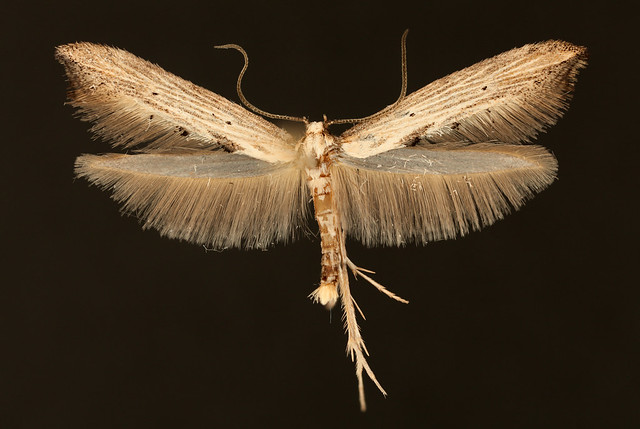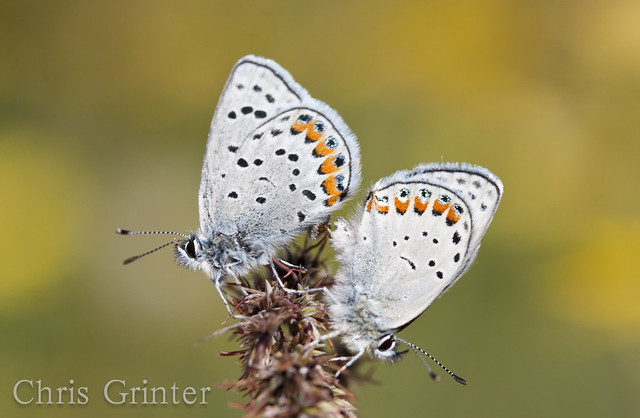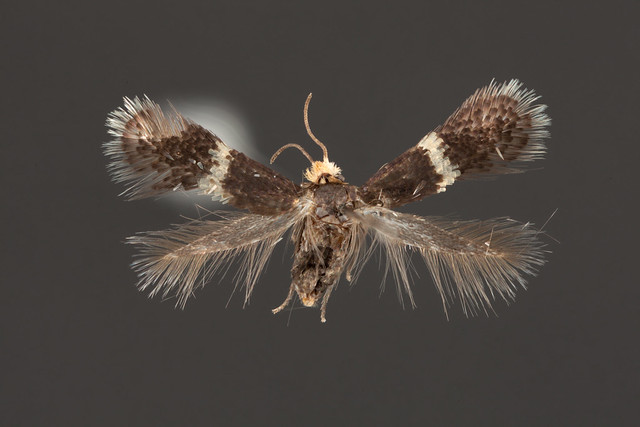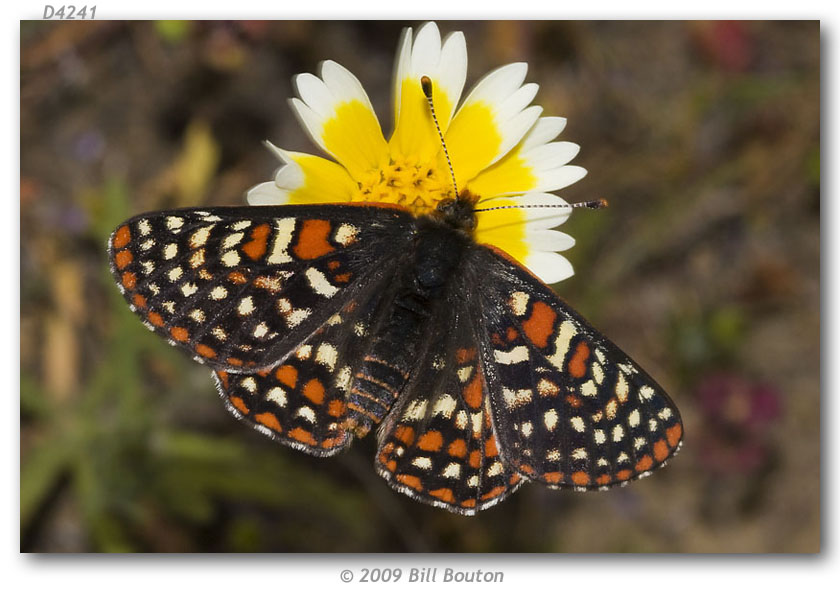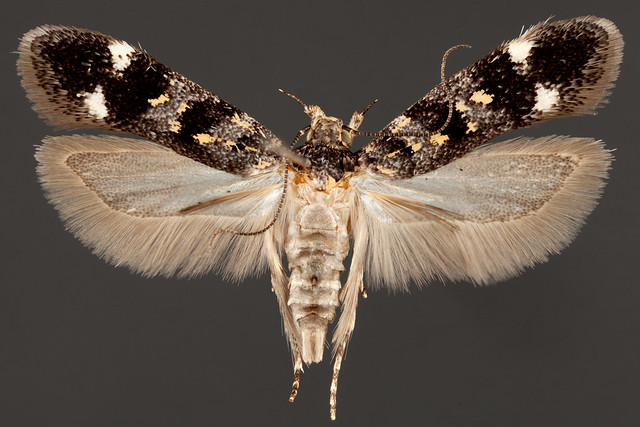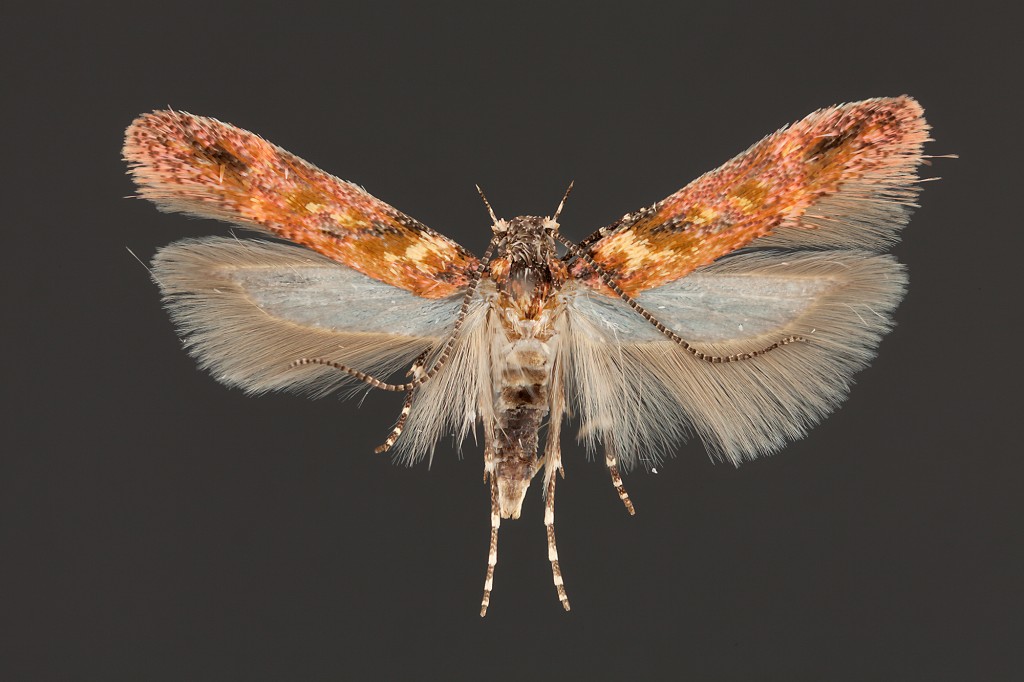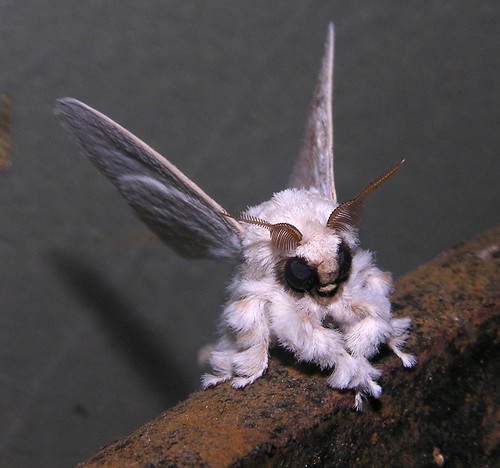Gaurko sits Rocky Mountains Denver kanpotik espezie eder bat da, Epermenia stolidota (Epermeniidae). Hau benetan bat ale handiagoak agertzen baino, wingtip tik 20mm to wingtip buruz. Horiek planteatu, iluntzen, tufts of scales on the posterior edge of the forewing is a great character for this family, as well as the stiff bristles on the hind tibia (also somewhat visible here). Badaude 11 species in 2 genera in the United States, with likely a few more to be discovered. Fellow curatorial assistant David Bettman keyed this species out using the revision of the Nearctic species: PDF here.
|
Aste honetan, txiki-txiki bat partekatzen ari naiz, scruffy, and semi-competently spread Nepticulidae in the genus Estigmella from the same light trap of Prescott Arizona as the past few Monday Moths. Ohi dut ez nuke argazki hori ez da baldintza onenetan sits baten partekatzeko, but I’m using this as an example of technique. Not only was this 4mm moth pulled out of the bottom of a light trap, but it was field pinned and dried for over a year and a half. I’ve always heard that it can nearly be impossible to deal with the smallest of the small; and for the most part I haven’t. I used to think you need to capture them off of a light sheet alive in a vial and euthanize moments before spreading, all while never, inoiz utzi pixka tiniest lehortu horiek aurretiaz. Baina bihurtzen da, ihes dezakezu ale duina lasaigarria by 24 ordu eta zabaltzeko hankaz gora. Jakina bat ontzi-tranpa bat irabiagailuan saihestu ale primeran freskoa baldin baduzu it a far superior ale egingo luke. Better oraindik, Hosto nirea bota duzu eta sits reared yourself. Nepticulidae horietako gehienak ostalari-jakin eta askoz ere anitzagoak dira baino kreditu eman ditugu horiek. Entzun dut ez behintzat izan daiteke 100 Espezie berrien aurkikuntza alone zain AEBetan. San Francisco tximeletak askoren historia oso ezaguna da eta etsigarriak dira. Gunea izan da, hein handi batean giza garapena eragin duela bi mendetik eta desagertua American tximeleta baten lehenengo adibidea ezaguna den gaiztoa etxean da, du Xerces blue. Beste tximeletak daude zintzilik bitartean, or getting help to hang on like the Mission Blue, some like the Bay Checkerspot have continued to decline despite valiant efforts for reintroduction. Today, the only known colony of the Bay Checkerspot is within Santa Clara County on a site called Coyote Ridge. It was twenty one years of intensive study of the checkerspot in the 1960’s and 70’s by the famous biologist Paul Ehrlich that provided the impetus for federal listing in 1987. Aurrera 1998 the colonies he studied have since gone extinct. Here is an excerpt from a 1980 paper in the Journal of the Lepidopterists’ Gizartea “Two California Checkerspot Butterfly Species, One New, One on the Verge of Extinction” (.pdf).
All efforts to relocate this butterfly have failed, and the future of this animal is not looking bright. And so what exactly is this creatures name? In 1937 Robert F. Sternitzky described what he thought to be an overlooked San Francisco butterfly “Euphydryas editha var. bayensis“. Those early descriptions of variations and races are roughly equivalent to today’s subspecies – and so the butterfly remained bayensis for decades and became a mascot for conservation. But where was the very first Euphydras editha from and how did the San Francisco bayensis differ? Unfortunately the original description is vague and the collecting locality is simply listed as “California”, as was the unfortunate habit of Boisduval who described the butterfly 1852. But all hope is not lost since the famous French Lepidopterist was having specimens sent to him by the earliest California Lepidopterist, Pierre Joseph Michel Lorquin. An eager gold prospector and butterfly collector, Lorquin traveled California from 1849 ra 1858 and again in 1869. Every butterfly that was sent back to France was a new species and subsequently described by Boisduval – who of course named one of California’s most beautiful butterflies after Lorquin. Enter Emmel, Emmel and Mattoon in 1994 who were writing the Systematics of Western North American Butterflies. In the process of cleaning up the mess of these early western species they had to designate a Lectotype for E. editha editha since Boisduval never fixed a Holotype in 1852. Essentially he named a new species without designating the taxonomic standard for the group, making future work ambiguous for taxonomists. Thankfully the travels of Lorquin have roughly been documented and we can ascertain that he should have been in San Francisco around 1849. Comparisons of the original specimens to the Bay Checkerspot made for an overwhelming case that it was this butterfly that was sent to France in the 19th century. The result of this finding therefore places the Bay Checkerspot Euphydryas editha bayensis into synonymy with the older name Euphydryas editha editha. The name bayensis effectively dissappeared because it was a re-description of a butterfly that was already known. Euphydryas e. editha as it turns out has been known from coastal California from the bay region down to San Luis Obispo – and so voila, the range of the Bay Checkerspot just exploded. But of course the story isn’t that simple and the butterfly didn’t become magically safe with a name change. Conservation groups and ecologist kicked and screamed and refused to accept the change, even the Xerces Society hasn’t jumped on board with the consensus of taxonomists out of what I can only assume is fear of the appearance that their butterfly is no longer endangered. I’ll emphasize that this doesn’t mean that the populations in the bay are no longer threatened – there is still a need for protecting these biologically significant populations as they are significantly declining. Habitats all throughout the region are facing ongoing and pernicious threats (pdf). All in all the name change is trivial, we can now call the Edith’s Checkerspot the Bay Checkerspot, and still fight to protect this butterfly. I’m unsure of what would be required to amend the federal register, and if it’s at all possible to expand protection of an animal like this without re-petitioning the endangered species act. So perhaps I can understand the failure to embrace the name change since from the outside it looks like their bug is no longer endangered. Bestalde, this could bring attention to populations of a butterfly that have been overlooked for decades.
Many thanks to John Pelham for conferring with me over this taxonomic headache.
Nola beste identificado Gelechiidae buruzko kokapena, aurreko ale gisa bereko (No. Prescott Arizona). Labankada bat hartzen ari naiz sits honetan generoko egoteko Chionodes – eta azaletik espeziearen antzekoa da C. continuella. Zorionez, ez dago talde honen monografia bat da (America Mexikoko North Moths, Fasciculus 7.6) eta dissect ahal izango dut eta, zorionez, identifikazio hobea iristen. Moths genitalian wonderfully sclerotized direla identifikaziorako erabiltzen pertsonaien aberastasuna eman daiteke egitura. Ziur genitalian zer laster itxura irudiak partekatzeko izan behar dut!
This moth is a good example of what a lot of my moths are at the moment – unidentified! This is certainly a Gelechiidae, you can see the large upturned palps on the front of the head, and a finger-shaped projection on the tips of the hindwings. Just about one of the easiest families of microleps to identify. And from a general gestalt perhaps this is in the Gnorimoschemini? If someone recognizes this little guy please let me know, otherwise I’ll attack the literature to try and track down the name. This beautiful moth is from the mountains outside of Prescott, AZ – Uztaila 2010. Rather enjoyably, there are so many microlepidoptera that are not easily identified. Agian dagoeneko entzun zenuen albiste harrigarria aldaketa historikoak Landa Museoaren Historia Naturalean Chicagon. Laburbilduz, museoko finantza krisian egon eta aldaketak masiboa ari da lehendakari berria garatu beharreko lanak joan, Richard Lariviere. Litekeena da hori, gehienez ikertzaileen erdia (tartean komisario titularrak) kaleratu eta ikerketa sail guztiak desegingo dira “zientzia eta hezkuntza”. Erakusketak modernizatzeko dirua gastatuko da, hori guztia museoaren muin zientifikoa zuritzen den bitartean. Mesedez, hartu une bat eskaera hau sinatzeko eta adierazi zure kezka: Babestu Ikerketa Landa MuseoanDuela hilabete batzuk zuetako askok seguruenik meme honetan zehar estropezuka – ospetsua Poodle Moth! Eta hain zuzen ere zati handiena jakinarazpena erdi duina izan zen. Bai, erreala da. Bai, sits bat da. Bai, seguruenik Lasiocampidae espezie bat (agian generoa Artace) gisa behar bezala zehaztu du by. John Rawlins. Hau guztia ondo eta ondo egotea espero nuen, tira, sits polit asko daude eta ordua da norbait ohartzeko! Artikulua irakurtzen ez nuen lankide batek helarazi zidan arte “Cosmic Log nbcnews.com webgunean“. Aurkitu nuena zen Benetako kalterik ez, baina kriptozoologia gauza oso horrek aspertu egiten nau. Penagarria iruditzen zait kriptozoologo batek hainbeste publizitate lortu eta sinesgarritasun handiz hitz egitea.. Kriptozoologia da ez zientzia bat, ezta inoiz izango. Kriptozoologia zientzia gisa egiten denean biologia deitzen zaio. Bai, benetako zientzia egiten ari direla uste duten intxaurrak daude, Ipuin luzeak zirkuluetan jarraituz eta anekdotiko pilak eraikiz “froga” badirudi inoiz ez dutela egiarik sortzen. Benetako aldeak daude zientzialari batek eta pseudozientzialari batek egiten duenaren artean. Esan zientzialari batek oihan sakonetan bizi den animalia bitxi baten berri entzuten duela – espedizio bati ekingo diote (diru laguntza eske ondoren) tokiko istorioak biltzeko eta oihanetan trekking edo ozeanoetan murgiltzeko aleak aurkitzeko lan gogorra egiteko. Ondoren, ale horiek etxera eramaten dituzte, xehetasun guztiak disekatu, eta emaitzak parekideen berrikuspeneko aldizkari batean argitaratu. Alerik aurkitu ez bada, zientzialari hori esku hutsik doa etxera eta izaki mitiko berri honen aukera birpentsatzen du.. Agian finantzaketa gehiagok denbora gehiago emango lioke eremuan… (beti erantzuna, Eskuineko?) Baina hor bukatzen da istorioa, frogarik gabe animalia ez da existitzen. Hortik aldentzen da kriptozoologia benetako zientziatik – istorio anekdotikoak egiatzat hartzen dituzte eta inoiz ez dute porrota onartzen. Nessy jendea delako existitzen da ikusi hura. Azalpena ezin daiteke izan aukera sinesgarriagoen sorta handia… kriptozoologo bat bizi den mundua mitikoa baita eta funtsean ez da erreala. Ados, nahikoa iragarkia, espero dezagun sits maitagarriagoak albisteen zikloan sartzea! Today’s moth is a stunning micro and another creature from Barb Bartell’s back yard in the Rockies. To the best of my knowledge it’s a species of Mompha (Coleophoridae), ziurrenik claudiella,but I don’t have a positive ID on this bug yet. Once I start digging through the micros from this site there are sure to be surprises! |
eszeptizismoa |
